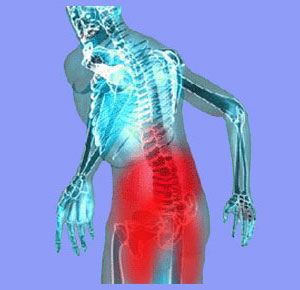
What is the difference between sciatica and lower back pain? The goal of this discussion is to provide a clear explanation that clarifies the answer to this question once and for all. After all, understanding sciatica is just the first and most important step in defeating it and regaining your life back from the pain.
So many people write to us stating that they have sciatica lower back pain. This is a contradiction, since these are 2 completely different symptoms. We have learned that despite its incredible frequency as one of the most common of all chronic pain syndromes, sciatica continues to be grossly misunderstood by most patients and even by many care providers. This fact provides lots of evidence supporting why sciatica is so difficult to cure. How can a cure be enacted if the symptomatic problem is not even understood at a fundamental level?
This discussion provides a clarification about the difference between sciatica and lower back pain and why these 2 pain syndromes should never be confused with one another.
Symptomatic Difference Between Sciatica and Lower Back Pain
Lower back pain describes symptoms that exist in the lumbar and sacral spinal regions. This pain might be centered over the spine, may be located off-center unilaterally or bilaterally, or might wrap around the lower back like a virtual belt of agony. Pain might be localized in specific regions or might be general, encompassing the entire lumbar region.
Sciatica describes a symptom set that includes pain, tingling, numbness and weakness in several different areas of the lower body, including the buttocks, legs and/or feet. Sciatica symptoms can exist wherever the sciatic nerve travels, which does not include the lower back. In fact, the nerve roots that form the sciatic nerve originate in the lower back, but do not actually form the nerve until further down in the anatomy.
Lower back pain and sciatica can, and often do, exist together. However, they should not be confused for each other, as they describe 2 completely different symptomatic locations, even if they do originate from the same singular source process.
Causative Difference Between Sciatica and Lumbar Back Pain
True spinally-motivated sciatica can only come from 2 source processes: compression and/or chemical irritation of the lumbar and sacral nerve roots (L4 to S3) which form the sciatic nerve. Compression can be caused within the central or foraminal canals by a wide range of possible direct causes and contributors, typically found acting in unison with one another. These factors might include disc desiccation, intervertebral herniation, osteoarthritic narrowing of the central and foraminal canal spaces, changes in lumbar lordosis and facet joint changes that might further reduce the patency of the neural foramen. Less common potential causes of true sciatica due to nerve root compression might include spondylolisthesis, lumbar scoliosis, previous lumbar surgery and congenitally-narrowed central or foraminal canals.
Sciatica caused by chemical irritation of nerve fibers will only occur due to the existence of an annular tear or ruptured disc that spills the substance named tumor necrosis factor alpha out of the disc nucleus and onto sensitive nerve fibers. Not all herniated discs involve the migration of nucleus proteins from the disc and not all people are susceptible to pain due to contact between nucleus proteins and nerve root tissues.
Meanwhile, lower back pain can come from a staggering selection of causative processes including all of the above sources of sciatica, due to nerve compression, as well as many, many more that do not create sciatic nerve symptomology, including: mechanical pain syndromes related to spinal bone movement with central or foraminal canal impingement, a diversity muscular pain and imbalance diagnoses and ischemia pain problems that involve chronic oxygen deprivation of affected tissues. It should be noted that ischemia can also cause sciatica symptoms, but is not a form of true sciatica, since it does not involve compression or chemical irritation of the nerve roots between L4 and S3. Instead, it might target these nerves for oxygen deprivation and threaten their functional integrity without any irritation or compression occurring.
Difference Between Sciatica and Lower Back Pain Regarding Treatment
Finding effective treatment requires targeting the actual source of symptoms. Many patients report undergoing various forms of care that might relieve their lower back pain, but their sciatica endures. Less commonly, the sciatica might be effectively treated, yet the lower back pain endures. Since these symptoms are often grouped together under the heading of “sciatica lower back pain”, there is a complete disconnect in the idea of therapeutic efficacy.
Sciatica and lower back pain might come from the same source or they may not. However, even when treatments address a singular causation, the efficacy of said treatment might work better for lumbar dorsalgia than for sciatica and vice versa. This is why it is of paramount importance to understand what is causing the lower back pain, what is causing the sciatica and how both sources can be resolved using specific forms of care. Statistics show that both low back pain and especially sciatica are often treatment-resistant chronic problems that defy attempts at active care for years. With the gross misunderstanding we have observed in the patient population and healthcare provider community, this fact does not surprise us one bit.
Sciatica > My Sciatica Story > Difference Between Sciatica and Lower Back Pain





